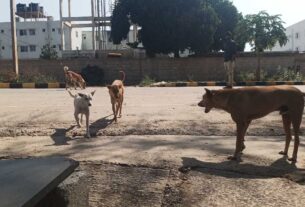While several southern states like Karnataka have achieved the required ratio of doctors per lakh population, rural areas continue to face shortage of specialist doctors.
If you live in an urban or metropolitan city, you have a range of hospitals and private clinics in a locality to choose from for your treatment. But Rahman Basheer, 49, does not have that option. His only option is a government hospital. But to get even a basic test done, the sole bread earner of his family has to spend hours in queue, forgoing his earnings for the day.
“To get my wife tested we have had to wait for more than five hours. Half of my day is gone here, who will go out now and work? It is already 2 p.m,” Rahman asked.
Manjunath Akolli, Assistant Medical Officer (AMO), Taluk Hospital, Hungund, said that the hospital only has seven doctors of the required strength of 15 . He added that several Primary Healthcare Centers (PHCs) in Hungund are also running with less than half capacity of required doctors and compounders.
However, the problem is not limited to specialist doctors—other medical staff required in the hospital for it to function properly are also far from the required numbers. According to Dr. Manjunath, the hospital only has seven compounders while the Taluk Hospital requires 32 compounders.
“For most things they (doctors) refer us to the district hospital in Bagalkot and we have to travel more than 30 kilo meters for that. It requires money and time to do that, we do not have money otherwise we would go to the private hospitals here,” Rahman said.
He explained that he could avoid the hassle of going far and spending money on transportation if the taluk hospital had the necessary facilities.
Gurulingappa Bhadrannavar, health inspector, Hungund, said, “The fact is that most doctors do not want to come to practice in rural areas and that is probably the reason why places like our taluk have fewer doctors than needed. It is also the reason why people go to bigger district hospitals but then those hospitals are overcrowded and the staff there is overworked as a result.”
According to the National Medical Commission, Karnataka has achieved the prescribed doctor to population ratio defined by the World Health Organization (WHO). The WHO prescribes a doctor population ratio of 1:1000.
As per the last census Hungund taluk has a population of over 4.2 lakhs. However, “the number of doctors in the taluk hospital, especially specialists is negligible,” said Gurulingappa Bhadrannavar.
Not just Karnataka, India has officially achieved the target of having one doctor for a population of thousand people.
Minister of State for Health, Bharati Pravin Pawar, in a written reply to Rajya Sabha informed that India now has a doctor to population ratio of 1:834 with more than 13 lakh allopathic doctors registered with the State Medical Councils and National Medical Council.
According to the Rural Health Statistics report, 2023, there is a shortfall of specialist doctors, including surgeons (83.2 percent shortfall), obstetricians and gynaecologists (74.2 percent), physicians (79.1percent) and pediatricians (81.6percent) in rural government hospitals in India.
Government data shows that while the overall shortage of specialists in Community Health Centers (CHCs) of rural areas is 80 per cent, shortage of specific specialists is even higher.
The reasons behind the shortage of specialists are many including most basic ones like the lack of facilities in rural areas. Dr. Rajeshwari B.S., a public health official and assistant professor at the Institute of Health Management Research said, “Every taluk level hospital should have gastro specialists, general physicians, general orthopedic doctors and obstetrics and gyanaecologists. But because of a lack of facilities and the difference in the standards of living in urban and rural spaces, new doctors, even if they are mandated to serve in rural areas, choose to quit and work in cities.”
According to a study by Human Resources for Health, nurses at PHCs and CHCs, and all specialist doctors at CHCs had very high workload pressure. A similar result was reported for CHC-specialist pairs—physicians and surgeons, physicians and pediatricians, and paediatricians and obstetricians–gynaecologists.
Although the government has been running several programs to strengthen the healthcare system since independence like Jan Arogya Yojana, National Health Mission, Ayushman Bharat, among others; experts say the benefits of all these schemes can only be achieved if the primary, community and taluk hospitals have enough infrastructure and staff.
Healthcare being a state subject, Karnataka government in 2023 did away with the law that requires Bachelor of Medicine, Bachelor of Surgery (MBBS) and super specialty graduates to serve in rural in rural areas for one year.
Experts say incentivizing doctors to practice in rural areas is one way to encourage them but sometimes that option does not work either. “You cannot force people to practice in a particular region. When someone pursues medicine, they have their own hopes and aspirations, if they do not want to work somewhere, authorities cannot force them. For many people, it is not even about money, it is more about the place and the facilities available,” Dr. Rajeshwari said.
First referrals
According to Karnataka Health Secretariat, Taluk Hospitals (THs) act as FRUs (First Referral Units) in providing emergency obstetrics care and neonatal care. They help in bringing down the Maternal Mortality and Infant Mortality and cater to the needs of taluk population.
Taluk Hospitals were to act as an important link between SC (Sub-Centre), PHC (Public Health Centre) and CHC on the one end and District Hospitals on the other.
A CHC is entitled to be upgraded when the catering population increases to five to six lakhs. A taluk hospital for a taluk with a population of five lakhs is around 100-150 beds. This facility is available in Hungund taluk hospital.




